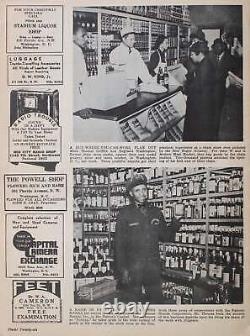African American Periodicals Entertainment Washington DC 1930s Photographs







3, 1938 Publication: Washington, D. Description: 11¾" x 8 7/8". Good plus: spine nearly perished; wrappers a bit soiled, spotted and worn with a few small chips; lightly toned throughout with some dings and chips at edges. This is a rare and fantastic issue of an African American "weekly newspicture magazine, " Flash!
The issue is overflowing with photographic images and write-ups of Black athletes, musicians, news makers and thrill seekers, as well as great illustrated ads, original poetry and art. Was founded in March 1937. The magazine was a source for national, international, society, sports and entertainment news for African Americans in Washington, Baltimore, Pittsburgh, New York and Chicago until it folded in August 1939. The present issue, released in January 1938, features an image of Dorothy Saulters on the cover, noting that she had just made her celluloid debut in Walter Wanger's'Vogues of 1938'. Saulters went on to a noteworthy career, performing at the Kit Kat Club, the Apollo and several years with Cab Calloway's Orchestra.
Other great musical content in the issue included images of dancers "rug-cutting" in some wild "swing sessions" and a color shot of New Orleans front woman "Jean Taylor of the Dixie Rhythm Girls" inside the rear cover. A "Who's Who In America" feature held images and brief bios of noted African Americans such as Mary McLeod Bethune, Josephine Baker, Joe Louis and C.One page was devoted to the work uncovering T. By modern methods by Thomas A.
Williston, a Howard graduate and instructor who served as a physician in the D. Health Department's Tuberculosis Bureau for 18 years. There were blurbs on religion, politics and world news, as well as a "Femininescope" feature that covered one of the Nation's most delightful personalities.
Elie Lescot, wife of Haiti's minister to the United States. Along with dozens of fantastic illustrated ads, the issue holds seven striking examples of the early art of George Elliot Olden, then a 16-year-old student at D. S all-Black Dunbar High School. At 24 Olden became the head art director for CBS' new television division, making him one of the earliest Black leaders in the industry.He later served as the official graphic designer for the U. International Secretariat and was the first African American to design a commemorative stamp for the United States Postal Service. There were also selections from poet Eve Lynn's No Alabaster Box, published in 1936. Eve Lynn was a pen name of Evelyn Reynolds, a social reformer in Philadelphia active with the Women's International League for Peace and Freedom and the National Urban League.
A rare survival of an overlooked African American periodical. OCLC shows only an entry for the magazine on microfilm, with just one holding, at the Wisconsin Historical Society.
The Danky Hady entry (2377) cited holdings at Howard but we scoured their catalog and found none, though we did locate one earlier issue online in a private collection. Subject: African Americana, Entertainment, Periodicals. This item is offered by Langdon Manor Books, LLC, antiquarian booksellers. We are members of the Antiquarian Booksellers' Association of America (ABAA), the International League of Antiquarian Booksllers (ILAB) and the Independent Online Booksellers Association (IOBA) and adhere to their rules of ethics.ALL ITEMS ARE GUARANTEED IN PERPETUITY TO BE AUTHENTIC AND ORIGINAL. This listing was created by Bibliopolis.

